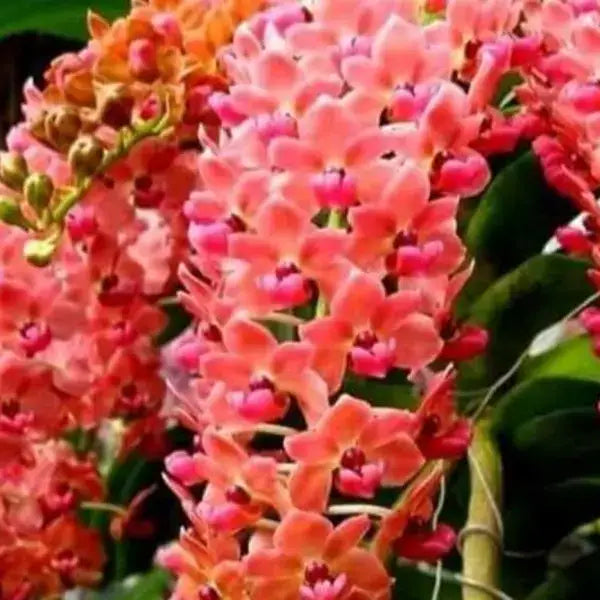
Rhynchostylis (RYS-007)
Selling Size : Last Image | Net Pot Included | Secure Packing
Rhynchostylis, often called "Foxtail Orchids" due to their striking, densely flowered spikes, are popular for their fragrant and beautiful blooms.
Here's a comprehensive guide to Rhynchostylis care:
1. Light:
Bright, indirect light is key. Rhynchostylis thrive in filtered sunlight, mimicking their natural habitat under tree canopies.
Avoid direct, harsh sunlight, especially during the strongest parts of the day, as it can scorch their leaves.
Ideal placement: An east or west-facing window is often suitable. If placing outdoors, ensure partial shade.
Insufficient light can lead to a lack of flowering.
2. Watering:
Rhynchostylis prefer to be kept evenly moist but not waterlogged.
Water thoroughly when the potting medium or roots begin to dry out.
Frequency: During active growth (spring and summer), water more frequently (even daily if mounted without media). Reduce watering slightly during the dormant season (fall and winter).
Ensure good drainage and quick drying of roots after watering to prevent root rot.
If grown mounted, you'll need to water more frequently, possibly daily, as they dry out faster.
3. Humidity:
High humidity is crucial. Rhynchostylis flourish in environments with 60% to 80% humidity.
To increase humidity: Use humidity trays, a room humidifier, or regular misting (ensure good air circulation to prevent fungal issues).
4. Temperature:
Rhynchostylis prefer warm temperatures.
Daytime temperatures: Ideally between 21-29°C (70-85°F).
Nighttime temperatures: A slight drop to 15-18°C (60-65°F) can help trigger blooming.
Protect them from frost.
5. Potting Media and Mounting:
Rhynchostylis are epiphytic, meaning they grow on other plants (like trees) in nature, not in soil.
They are often grown in baskets without any potting medium or with a very coarse, fast-draining mixture.
Recommended potting mixes include fir bark and charcoal in equal parts, allowing roots to dry quickly.
Mounting on cork slabs or tree ferns is also an excellent option, especially for established plants. If mounted, they will require more frequent watering.
They dislike root disturbance, so choose your growing method carefully.
6. Fertilizing:
During active growth (spring and summer), feed weekly with 1/4 to 1/2 of the recommended dose of a balanced orchid fertilizer.
Some growers use a high-nitrogen fertilizer during intensive growth and switch to a high-phosphorus fertilizer in late summer and fall to promote flowering.
Avoid fertilizing during the winter rest period.
Foliar application of a dilute fertilizer solution directly onto the roots can also be beneficial.
Research suggests that specific nutrient optimization, like calcium (500 ppm) for growth and zinc (750 ppm) for flowering, can be highly effective.
7. Air Circulation:
Good air circulation is essential to prevent fungal diseases, especially in high humidity environments.
8. Pests and Diseases:
Rhynchostylis can be susceptible to common orchid pests like spider mites, scale insects, and aphids. Inspect your plant regularly and treat promptly with insecticidal soaps or neem oil if needed.
Fungal and bacterial infections can occur, often due to excess moisture and poor air circulation. Symptoms include leaf blotch, dark spots, and root rot. Ensure good air circulation and appropriate watering.
Underwatering can lead to yellowing or wilting leaves.
Overwatering can cause root rot, also leading to yellowing leaves.
9. Repotting:
Rhynchostylis generally dislike root disturbance, so repot only when absolutely necessary (e.g., the plant has outgrown its container or the medium has broken down).
If repotting, be very cautious as their roots can be brittle.
By providing these specific conditions, you can enjoy the stunning and fragrant blooms of your Rhynchostylis orchid for many years.

